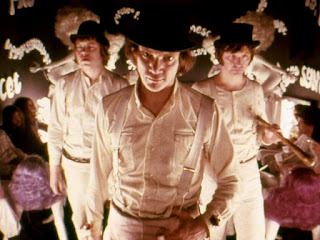Film Review: A Clockwork Orange
For what is to be the first in my series of film reviews, I have decided to start with the film I watched most recently. This film was Stanley Kubrick’s controversial 1971 crime film ‘A Clockwork Orange’. As a fan of films and TV with psychotic characters that focus on delving into their twisted mind (American Psycho, The Talented Mr Ripley, and the Hannibal Lecter franchise to name a few) I went into the film with high expectations and when it finished, I felt that for the most part these expectations were met.
To briefly summarise the film without spoiling it, the narrative focuses on Alex DeLarge (Malcom McDowell), a young sociopath who enjoys nothing more than assaulting innocents (except maybe classical music). After being apprehended for a particularly heinous crime, Alex is made to watch violent and horrific imagery in hopes of scaring him away from future acts. Whilst the film is most associated with its earlier scenes where we get to see Alex (complete with his iconic bowler hat and extended eyelash) terrorise anyone in his way, the later sections of the story remain just as engaging as we see the aftermath of Alex’s actions and punishment. It is also in these scenes that the film explores its main questions and themes a notable one being whether people should have free will or be forced into being ‘morally correct’. Through this Alex is also made into a remarkably interesting character as we see him as both the embodiment of pure evil and as a scared boy abused by higher-ups in society. As such, Alex is a great example of a morally dubious character where the audience is never truly sure whether they feel Alex’s punishment is just.
The strongest aspects of ‘A Clockwork Orange’ would be its aesthetics and musical score. Visually the film is stunning, using bright and eccentric sets and costumes to create a unique style that is unlike many other films. One of the best instances of this is in the opening scene where Alex and his gang are in the milk bar, dressed in the same outlandish outfits. As the camera slowly zooms out, we see that the tables and decorations are mannequins of women, their hair unnaturally coloured or in strange styles. The scene feels surreal and perfectly sets the tone for the rest of the film. This is combined with the film’s soundtrack which primarily consists of classical music, reflecting Alex’s own music taste and adding a triumphant atmosphere towards even some of the darkest scenes in the film. By using this aesthetic and soundtrack over the horrific acts of violence, Stanley Kubrick creates a powerful juxtaposition which creates an almost dream-like feeling to the scenes, helping immerse the viewer into Alex’s depraved fantasies and view of the world.
The only complaint I have about ‘A Clockwork Orange’ would be the level of violence, or more rather what felt to me like a lack of violence. This film is infamously known for having been banned in many areas due to the themes and heavy violence, yet I felt that the scenes of ‘ultraviolence’ didn’t quite meet my expectations. In many scenes the acts are shown from a distance or cut away before anything too graphic as to only allude to it. Of course, it is important to remember that his film is fifty years-old this year so was limited by filmmaking techniques and regulations of the time but part of me was mildly disappointed by this. However, this issue may be less about the film itself and instead be about my own tolerance to on-screen violence. With filmmaking techniques having improved so much since the release of this film it is easier to create graphic scenes, to the point that it could be argued we as an audience are more tolerant to fictional violence and gore. As a result, there’s something ironic that a film that proposes that overexposure to violence will make us resent it has had its effect dulled by my own overexposure to it.
In conclusion, ‘A Clockwork Orange’ is a solid film that blends an interesting character and engaging story with a unique style created by Stanley Kubrick, only lessened by an increasing tolerance to fictional violence. I am also grateful to this film as I can feel its influence on other media products I enjoy such as the 1989 back comedy ‘Heathers’ which features Christian Slater as another young sociopath known for his poetic style of speaking, with striking similarity to Alex. For me, ‘Heathers’ also takes several visual cues from ‘A Clockwork Orange’ in terms of its style. As a result, I am pleased to have watched this film and look forward to watching more of Kubrick’s films in the future.



As violent as it is(n’t), it’s a masterpiece of dystopian satire. That said, it’s not one of my favourites but hey, it’s good to watch something different 🤷♀️
ReplyDeleteWhat a refreshing write up of a cult classic - look forward to your future posts!
ReplyDeleteAn interesting review. I have to say that I'm not a big fan of 'A Clockwork Orange', and not of Kubrick's films in general (apart from 'Full Metal Jacket'...and maybe 'The Shining'). This may have more to do with when I last watched the film, as I was probably nearer your age (so a long time ago....in a galaxy far far away). I must say that I wasn't able to infer all that you did, nor would I have been able to write such an eloquent review. Well done.
ReplyDeleteInterestingly I read somewhere that it was Kubrick himself who pulled the movie from theatres in the UK, as a result of his concerns over copycat attacks.
I fully concur Jimmer. I read somewhere that Kubrick was a nightmare to work with and had a superiority complex
Delete